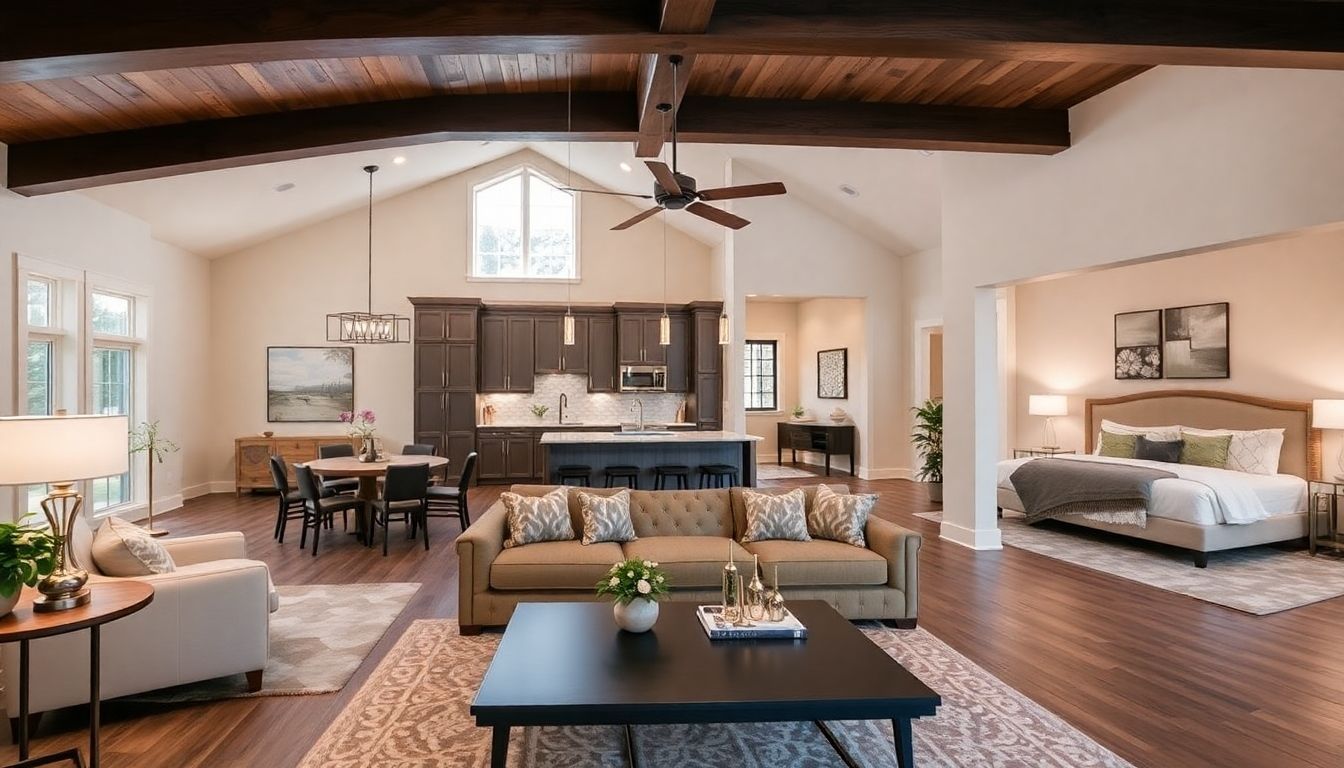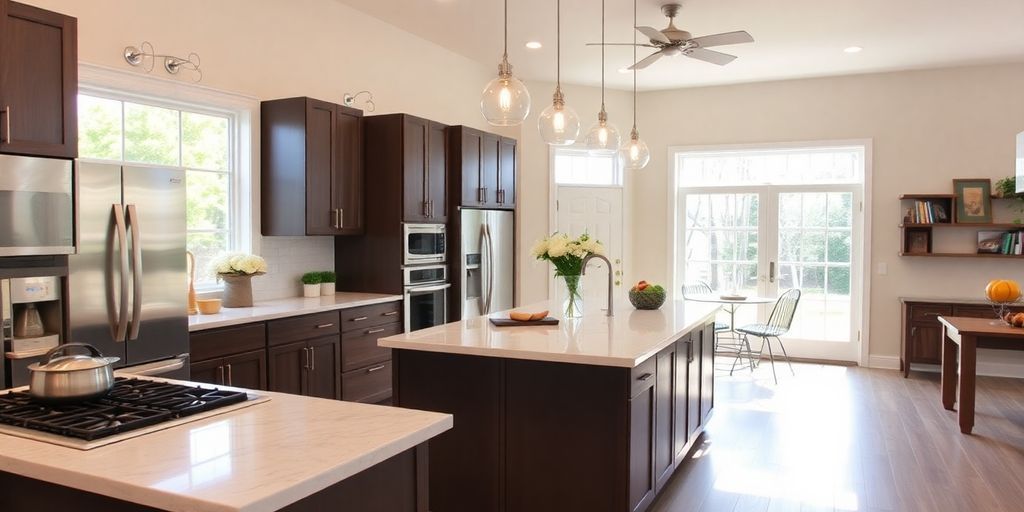What’s Included in a Custom Home Build? A Room-by-Room Breakdown

Building a custom home is an exciting journey, but it can also feel overwhelming. There are so many details to consider, from the layout and design to the materials and finishes. To help you navigate this process, we’ve put together a comprehensive custom home building checklist that breaks down everything room by room. Whether you're dreaming of a spacious kitchen or cozy bedrooms, this guide will give you a clearer picture of what to expect as you create your perfect home.
Key Takeaways
- Start with a solid budget to guide your decisions.
- Choose your location wisely; it impacts your build and lifestyle.
- Focus on essential rooms first, like the kitchen and living areas.
- Select finishes and fixtures early to avoid delays and extra costs.
- Work closely with professionals to ensure your vision is realized.
Understanding Your Custom Home Building Checklist
Building a custom home is a big deal! It's exciting, but it can also feel overwhelming if you don't have a plan. That's where a checklist comes in handy. Think of it as your roadmap to making your dream home a reality. It helps you stay organized, on budget, and (hopefully) stress-free. Let's break down some key things to consider before you even start hammering nails.
Key Considerations for Your Build
Before diving into the specifics, take a step back and think about the big picture. What are your must-haves? What are you willing to compromise on? This initial brainstorming session is crucial.
- Lifestyle: How do you live? Do you need a home office? A big backyard for the kids? An open-concept kitchen for entertaining?
- Future Needs: Are you planning to expand your family? Do you anticipate needing space for aging parents? Think long-term.
- Aesthetics: What style of home do you envision? Modern? Traditional? Farmhouse? Start gathering inspiration from magazines, websites, and floor plans.
It's easy to get caught up in the excitement of choosing finishes and appliances, but don't lose sight of the fundamental reasons why you're building a custom home in the first place. Keep your lifestyle, future needs, and aesthetic preferences at the forefront of every decision.
Setting a Realistic Budget
Okay, let's talk money. This is arguably the most important part of the entire process. Be honest with yourself about what you can afford. It's better to scale back your plans now than to run out of money halfway through the build.
- Get pre-approved for a mortgage. This will give you a clear idea of your borrowing power.
- Research construction costs in your area. Prices can vary significantly depending on location and materials.
- Factor in unexpected expenses. There will always be surprises, so pad your budget accordingly.
Choosing the Right Location
Location, location, location! It's not just a real estate cliché; it's a fundamental consideration. Think about your commute, schools, access to amenities, and the overall neighborhood vibe.
- Commute: How far are you willing to drive to work, school, or other important destinations?
- Schools: If you have children, research the quality of the local schools.
- Amenities: Do you want to be close to shopping, restaurants, parks, or other recreational facilities?
Essential Rooms in Your Custom Home
When you're building a custom home, thinking about the essential rooms is a big deal. It's not just about having a place to sleep or cook; it's about creating spaces that truly fit your lifestyle. Each room should be designed with your specific needs and preferences in mind. Let's break down some of the most important rooms to consider:
Designing the Living Room
The living room is often the heart of the home, a place for relaxation, entertainment, and family gatherings. When designing this space, think about:
- Layout: How will furniture be arranged to encourage conversation and create a comfortable flow? Consider the placement of windows and doors.
- Functionality: Will this space be primarily for watching TV, reading, or entertaining guests? Plan accordingly with appropriate seating, lighting, and storage.
- Aesthetics: What style and mood do you want to create? Choose colors, textures, and decor that reflect your personal taste and create a welcoming atmosphere.
The living room should be a reflection of your personality and a space where you feel comfortable and at ease. Don't be afraid to experiment with different layouts and design elements to find what works best for you.
Creating Functional Bedrooms
Bedrooms are more than just places to sleep; they're personal sanctuaries. Here's what to keep in mind when designing your bedrooms:
- Size and Layout: Consider the size of the room and how it will be used. Will it be a simple sleeping space, or will it also include a sitting area or workspace?
- Storage: Adequate storage is key to keeping bedrooms organized and clutter-free. Think about closet space, built-in shelving, and dressers. When selecting a floor plan for your custom home, consider essential features like adequate closet space.
- Lighting: A combination of natural and artificial light is important. Include windows for natural light, as well as overhead lighting, lamps, and reading lights.
Planning the Kitchen Layout
The kitchen is often considered the most important room in the house. A well-designed kitchen can make cooking and entertaining a joy. Consider these factors when planning your kitchen layout:
- Workflow: Think about the flow of activity in the kitchen. The classic work triangle (sink, stove, refrigerator) is a good starting point, but customize it to fit your cooking style.
- Storage: Maximize storage space with cabinets, drawers, and pantry solutions. Consider pull-out shelves, spice racks, and other organizational features.
- Appliances: Choose appliances that fit your needs and budget. Consider energy-efficient models and features that will make cooking easier and more enjoyable.
Interior Finishes and Selections
This is where your custom home really starts to feel like your home. It's all about the details that reflect your personal style and make the space unique. Getting these choices right can make a huge difference in the overall look and feel, and even the long-term value of your home.
Choosing Flooring Options
Flooring is a big decision, impacting both aesthetics and functionality. Think about the traffic in each area and the kind of wear and tear it will endure. There are so many options, it can be overwhelming! Here are a few to consider:
- Hardwood: Classic and beautiful, but can be pricey and require maintenance.
- Tile: Great for bathrooms and kitchens, durable and water-resistant.
- Carpet: Adds warmth and comfort, but can stain easily.
- Laminate: A budget-friendly option that mimics the look of wood or tile.
Don't forget to factor in the subfloor! It needs to be level and properly prepared to ensure your flooring lasts. Also, consider the overall style of your home. A rustic farmhouse might call for wide-plank hardwood, while a modern condo could benefit from sleek concrete floors.
Selecting Paint Colors
Paint is one of the most impactful and affordable ways to transform a space. But choosing the right colors can be tricky. Here's what I've learned:
- Consider the lighting: Natural light versus artificial light can drastically change how a color looks.
- Think about the mood: Do you want a calming and serene bedroom, or a vibrant and energetic living room?
- Test, test, test: Always get samples and paint a small area before committing to an entire room.
Don't be afraid to experiment with accent walls or different sheens. And remember, paint colors can also affect the perceived size of a room. Lighter colors tend to make spaces feel larger, while darker colors can create a cozy and intimate atmosphere. If you need help, consider interior design to guide you.
Deciding on Fixtures and Appliances
Fixtures and appliances are more than just functional; they're design elements in their own right. From lighting to faucets to ovens, these choices can really elevate the look of your home.
- Lighting: Chandeliers, recessed lighting, pendant lights – the options are endless. Think about layering light for different moods and tasks.
- Plumbing fixtures: Faucets, showerheads, and sinks come in a variety of styles and finishes. Consider water efficiency and durability.
- Appliances: Stainless steel, black, or custom panels? Choose appliances that fit your cooking style and complement your kitchen design. Don't forget to check out smart home technology for modern options.
Don't skimp on quality when it comes to fixtures and appliances. These are items you'll be using every day, and investing in durable, well-made products will save you money in the long run. Also, think about energy efficiency. Energy Star appliances can help lower your utility bills and reduce your carbon footprint.
Exterior Features and Landscaping
Selecting Siding and Roofing Materials
Choosing the right siding and roofing is a big deal. It's not just about looks; it's about protection from the elements and how long your house will last. There are so many options these days, from traditional brick and wood to more modern materials like fiber cement and metal. Each has its pros and cons in terms of cost, maintenance, and how well they stand up to weather. Think about the climate you live in and pick materials that can handle it.
- Consider the insulation properties of different materials.
- Research the long-term maintenance requirements.
- Get quotes from multiple suppliers and installers.
Don't skimp on quality here. A cheap roof or siding might save you money upfront, but you'll likely pay more in repairs and replacements down the road. It's worth investing in durable, weather-resistant materials that will protect your home for years to come.
Designing Outdoor Spaces
Your outdoor space is an extension of your home, so it should be functional and inviting. Think about how you want to use the area. Do you want a large patio for entertaining? A cozy deck for relaxing? A garden for growing your own food? Plan the layout carefully to maximize space and create a comfortable flow. Consider adding features like:
- Outdoor lighting to create ambiance and improve safety.
- A fire pit or outdoor fireplace for cool evenings.
- A water feature, like a fountain or pond, for a calming effect.
Incorporating Sustainable Features
Making your home more sustainable is good for the environment and can save you money in the long run. There are many ways to incorporate sustainable features into your exterior and landscaping. For example:
- Use permeable pavers for driveways and walkways to reduce runoff.
- Install a rainwater harvesting system to collect water for irrigation.
- Plant native plants that require less water and attract pollinators.
Utilities and Systems Installation
Plumbing and Electrical Considerations
When planning your custom home, don't skimp on the infrastructure. Plumbing and electrical systems are the veins and arteries of your house, and getting them right from the start is way cheaper than fixing problems later. Think about things like:
- The placement of outlets. Seriously, put them everywhere. You'll never regret having too many.
- Water heater type. Tankless can save space and energy, but they might require a gas line upgrade.
- Future-proofing. Run extra conduit for future upgrades. You'll thank yourself later when you want to add smart home features or an EV charger.
Consider installing a whole-house water filter on the incoming water supply. It's a relatively inexpensive way to protect your pipes and appliances from sediment and debris.
Heating and Cooling Systems
Choosing the right HVAC system is a big deal for comfort and energy bills. Here's what to keep in mind:
- Consider a variable-speed AC unit. They're more efficient and provide more consistent temperatures than traditional single-stage units.
- Think about zoning. Being able to control the temperature in different areas of the house can save energy and keep everyone happy.
- Don't forget about ventilation. A good ventilation system will improve indoor air quality and reduce the risk of mold and mildew.
Smart Home Technology Integration
Smart home tech isn't just a fad; it can actually make your life easier and save you money. Integrating these systems during construction is much easier than retrofitting later. Some ideas:
- Smart lighting. Control your lights from your phone, set schedules, and save energy.
- Smart thermostats. Learn your habits and adjust the temperature automatically.
- Security systems. Protect your home with cameras, sensors, and alarms.
- Consider wiring for electric vehicle charging in the garage. Even if you don't have an EV now, you might in the future.
Final Touches Before Moving In
Conducting a Final Walkthrough
Okay, so the house is basically done, right? Not so fast! This is where you grab your builder and go through every single room, closet, and corner. The final walkthrough is your chance to catch anything that's not quite right before you officially take ownership. Make a list, take pictures, and don't be shy about pointing out even small imperfections. It's way easier to get things fixed now than after you've moved all your stuff in.
Understanding Home Maintenance
Think of your new house like a brand-new car. It needs regular check-ups and maintenance to keep it running smoothly.
Here's a few things to consider:
- Changing air filters regularly.
- Checking your roof and gutters.
- Knowing where your main water shut-off valve is located (trust me, you'll want to know this!).
- Understanding your smart home systems.
It's a good idea to create a home maintenance schedule and stick to it. This will help you avoid costly repairs down the road and keep your home in tip-top shape.
Preparing for Moving Day
Moving day can be super stressful, but with a little planning, it doesn't have to be a complete disaster.
Here are some tips:
- Book your movers well in advance.
- Start packing early (seriously, don't wait until the last minute).
- Label everything clearly.
- Pack an "essentials" box with things you'll need right away, like toiletries, medications, and a change of clothes.
- Confirm utilities are switched to your name.
Navigating the Custom Home Building Process
Building a custom home is a big deal, and it can feel overwhelming. But don't worry, breaking it down into smaller steps makes it much easier to handle. It's all about knowing what to expect and having the right people on your side.
Working with Architects and Designers
Architects and designers are your creative partners. They help turn your vision into a tangible plan. Finding the right architect is key – someone who gets your style and can translate your ideas into blueprints.
- Discuss your lifestyle and needs.
- Review their portfolio and past projects.
- Make sure their communication style works for you.
Choosing a Builder
Selecting a builder is one of the most important decisions you'll make. Your builder is responsible for bringing the design to life, managing the construction, and keeping the project on track. Check their references, look at their previous work, and make sure they're licensed and insured. A good builder will be transparent, communicative, and committed to quality.
Understanding Permits and Regulations
Dealing with permits and regulations can be a headache, but it's a necessary part of the process. Building codes, zoning laws, and environmental regulations all need to be followed. Your architect or builder can help you understand permits and regulations and navigate the paperwork, but it's good to have a basic understanding yourself.
Ignoring these rules can lead to delays, fines, or even having to tear down work, so it's best to get it right from the start.
Building your own home can be exciting but also a bit tricky. It’s important to know what steps to take to make the process smoother. From choosing the right land to picking the perfect design, every choice matters. If you want to learn more about how to build your dream home, visit our website for helpful tips and guidance!
Wrapping It Up
Building a custom home is a big deal, and it can feel like a lot to take in. From picking out the right lot to deciding on every little detail in each room, it’s all part of the journey. You’ve got to think about your budget, the layout, and what features matter most to you. Sure, it can be overwhelming, but remember, this is your chance to create a space that truly reflects who you are. Take your time, make thoughtful choices, and don’t hesitate to ask for help when you need it. In the end, you’ll have a home that’s not just a place to live, but a place that feels like you.
Frequently Asked Questions
What should I consider when planning my custom home?
You need to think about your budget, how much space you want, and where you want to build your home.
How do I set a budget for my custom home?
Start by deciding what features you want and how much you can afford. This will help you create a budget that works.
What are the main rooms I should include in my custom home?
Make sure to plan for a living room, bedrooms, and a kitchen. These are essential for any home.
What kind of finishes should I choose for my home?
Consider things like flooring, paint colors, and fixtures. These details make your home feel complete.
How important is landscaping for my new home?
Landscaping adds beauty and value to your home. Think about outdoor spaces and plants you want.
What are the last steps before I move in?
Do a final walkthrough of the home, learn about maintenance, and get ready for moving day.


